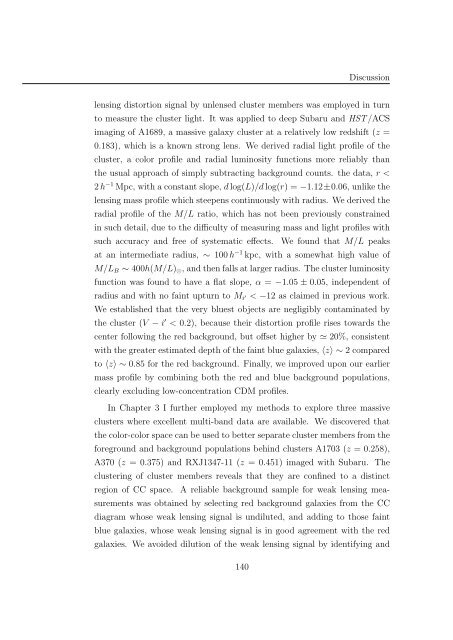Mass and Light distributions in Clusters of Galaxies - Henry A ...
Mass and Light distributions in Clusters of Galaxies - Henry A ...
Mass and Light distributions in Clusters of Galaxies - Henry A ...
Create successful ePaper yourself
Turn your PDF publications into a flip-book with our unique Google optimized e-Paper software.
Discussion<br />
lens<strong>in</strong>g distortion signal by unlensed cluster members was employed <strong>in</strong> turn<br />
to measure the cluster light. It was applied to deep Subaru <strong>and</strong> HST /ACS<br />
imag<strong>in</strong>g <strong>of</strong> A1689, a massive galaxy cluster at a relatively low redshift (z =<br />
0.183), which is a known strong lens. We derived radial light pr<strong>of</strong>ile <strong>of</strong> the<br />
cluster, a color pr<strong>of</strong>ile <strong>and</strong> radial lum<strong>in</strong>osity functions more reliably than<br />
the usual approach <strong>of</strong> simply subtract<strong>in</strong>g background counts. the data, r <<br />
2 h −1 Mpc, with a constant slope, d log(L)/d log(r) = −1.12±0.06, unlike the<br />
lens<strong>in</strong>g mass pr<strong>of</strong>ile which steepens cont<strong>in</strong>uously with radius. We derived the<br />
radial pr<strong>of</strong>ile <strong>of</strong> the M/L ratio, which has not been previously constra<strong>in</strong>ed<br />
<strong>in</strong> such detail, due to the difficulty <strong>of</strong> measur<strong>in</strong>g mass <strong>and</strong> light pr<strong>of</strong>iles with<br />
such accuracy <strong>and</strong> free <strong>of</strong> systematic effects. We found that M/L peaks<br />
at an <strong>in</strong>termediate radius, ∼ 100 h −1 kpc, with a somewhat high value <strong>of</strong><br />
M/L B ∼ 400h(M/L) ⊙ , <strong>and</strong> then falls at larger radius. The cluster lum<strong>in</strong>osity<br />
function was found to have a flat slope, α = −1.05 ± 0.05, <strong>in</strong>dependent <strong>of</strong><br />
radius <strong>and</strong> with no fa<strong>in</strong>t upturn to M i ′ < −12 as claimed <strong>in</strong> previous work.<br />
We established that the very bluest objects are negligibly contam<strong>in</strong>ated by<br />
the cluster (V − i ′ < 0.2), because their distortion pr<strong>of</strong>ile rises towards the<br />
center follow<strong>in</strong>g the red background, but <strong>of</strong>fset higher by ≃ 20%, consistent<br />
with the greater estimated depth <strong>of</strong> the fa<strong>in</strong>t blue galaxies, 〈z〉 ∼ 2 compared<br />
to 〈z〉 ∼ 0.85 for the red background. F<strong>in</strong>ally, we improved upon our earlier<br />
mass pr<strong>of</strong>ile by comb<strong>in</strong><strong>in</strong>g both the red <strong>and</strong> blue background populations,<br />
clearly exclud<strong>in</strong>g low-concentration CDM pr<strong>of</strong>iles.<br />
In Chapter 3 I further employed my methods to explore three massive<br />
clusters where excellent multi-b<strong>and</strong> data are available. We discovered that<br />
the color-color space can be used to better separate cluster members from the<br />
foreground <strong>and</strong> background populations beh<strong>in</strong>d clusters A1703 (z = 0.258),<br />
A370 (z = 0.375) <strong>and</strong> RXJ1347-11 (z = 0.451) imaged with Subaru. The<br />
cluster<strong>in</strong>g <strong>of</strong> cluster members reveals that they are conf<strong>in</strong>ed to a dist<strong>in</strong>ct<br />
region <strong>of</strong> CC space. A reliable background sample for weak lens<strong>in</strong>g measurements<br />
was obta<strong>in</strong>ed by select<strong>in</strong>g red background galaxies from the CC<br />
diagram whose weak lens<strong>in</strong>g signal is undiluted, <strong>and</strong> add<strong>in</strong>g to those fa<strong>in</strong>t<br />
blue galaxies, whose weak lens<strong>in</strong>g signal is <strong>in</strong> good agreement with the red<br />
galaxies. We avoided dilution <strong>of</strong> the weak lens<strong>in</strong>g signal by identify<strong>in</strong>g <strong>and</strong><br />
140
















